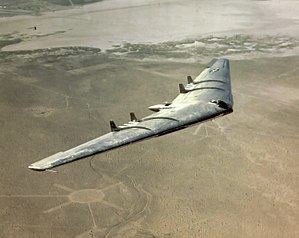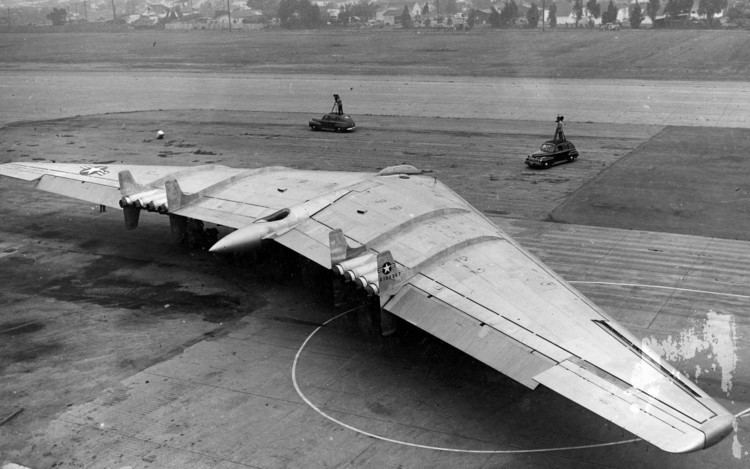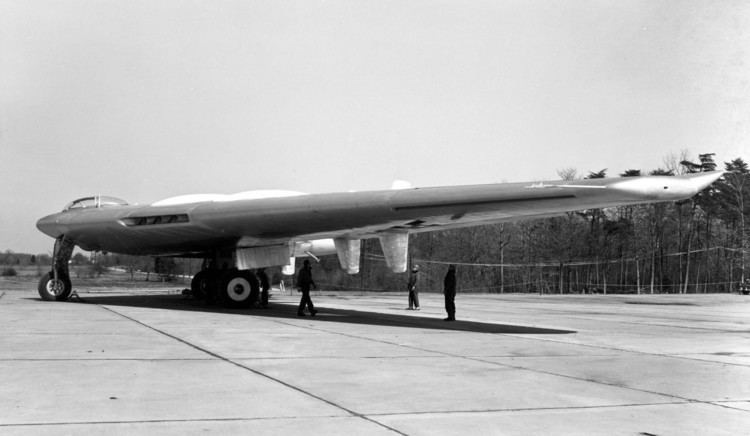Top speed 797 km/h Wingspan 52 m Engine types Turbojet, Allison J35 | Range 16,057 km Length 16 m First flight October 21, 1948 | |
 | ||
Similar Northrop N 9M, Northrop N 1M, Northrop YB 35 | ||
Fsx northrop yb 49 test flight
The Northrop YB-49 was a prototype jet-powered heavy bomber aircraft developed by Northrop Corporation shortly after World War II for service with the U.S. Air Force. The YB-49 featured a flying wing design and was a jet-powered development of the earlier, piston-engined Northrop XB-35 and YB-35. The two YB-49s actually built were both converted YB-35 test aircraft.
Contents
- Fsx northrop yb 49 test flight
- Design and development
- Operational history
- Notable appearances in media
- Specifications YB 49
- References

The YB-49 never entered production, being passed over in favor of the more conventional Convair B-36 piston-driven design. Design work performed in the development of the YB-35 and YB-49 nonetheless proved to be valuable to Northrop decades later in the eventual development of the B-2 stealth bomber, which entered service in the early 1990s.

Design and development

With the XB-35 program seriously behind schedule by 1944, and the end of piston-engined combat aircraft in sight, the production contract for this propeller-driven type was cancelled in May of that year. Nevertheless, the Flying Wing design was still sufficiently interesting to the Air Force that work was continued on testing a single YB-35A production aircraft.
Among the aircraft later completed were two airframes that the Air Force ordered be fitted with jet propulsion and designated as YB-49s. The first of these new YB-49 jet-powered aircraft flew on 22 October 1947 (from Northrop airfield in Hawthorne, CA) and immediately proved more promising than its piston engined counterpart. The YB-49 set an unofficial endurance record of staying continually above 40,000 ft (12,200 m) for 6.5 hours.
The second YB-49 was lost on 5 June 1948, killing its pilot, Major Daniel Forbes (for whom Forbes Air Force Base was named), co-pilot Captain Glen Edwards (for whom Edwards Air Force Base is named), and three other crew members, one of whom, 1st Lieutenant Edward Lee Swindell, was a crew member on the Boeing B-29 that assisted Chuck Yeager in breaking the sound barrier in the Bell X-1 aircraft. Their aircraft suffered structural failure, with both outer wing sections becoming detached from the center section. Speculation at the time was that the YB-49 was lost due to excessive pullout loads imposed on the heavy airframe when a scheduled flight test of the large bomber's stall recovery resulted in a sudden and dramatic high-speed, nose-over dive. The post-stall high-speed dive resulted from the clean, low-drag, all-wing design, which gave the YB-49 a rapid speed increase in any type of dive. Fellow YB-49 test pilot Robert Cardenas later claimed that the YB-49 rotated backwards in stall, and that he warned Edwards about it. Jack Northrop later countered that such a behavior was impossible for the all-wing design.
On 9 February 1949, the first YB-49 flew from Muroc Air Force Base in California to Andrews Air Force Base near Washington, D.C., in 4 hours 25 minutes, after which President Truman ordered a flyby of Pennsylvania Avenue at rooftop level. The return flight from Andrews was marred when four of the eight engines had to be shut down due to oil starvation. Inspection after a successful emergency landing at Winslow Airport, Arizona, revealed no oil had been replaced in these engines at Wright after the Muroc-to-Andrews leg, raising a suspicion of industrial sabotage.
The last operational YB-49 prototype was destroyed on 15 March 1950, during high-speed taxi trials at Muroc Field. The nose wheel began to encounter severe vibration problems and finally collapsed; the aircraft was completely destroyed in the ensuing fire. The taxi trials took place with the YB-49's fuel tanks full, an unusual testing procedure, fanning further speculation of industrial sabotage of the aircraft.
The Air Force ordered the remaining uncompleted YB-35 piston-engined airframes be completed as production B-35B aircraft.
Bombing target tests showed a tendency of flying wings to "hunt" in yaw after turns and when flying in "disturbed" air, degrading bombing accuracy. It was thought that one of the new Honeywell autopilots, with yaw damping, would correct this flaw. Northrop chief test pilot on the YB-35 and YB-49 programs Max Stanley contends in the 1992 Discovery Channel documentary "The Wing Will Fly", the adaptation of the autopilot in this dual function "damped out the directional oscillations to the degree where,...I think you would say it met the (military) specifications." Brig. General Robert Cardenas also flew the YB-49 during many of its test flights, praising the aircraft for its marvelous performance, while also noting the YB-49 required a very long bomb run to dampen out directional oscillations. Many of these challenges would eventually be overcome when fly-by-wire systems and computer-generated artificial stability became available in the 1970s, culminating in the development of the all-wing Northrop Grumman B-2 Spirit Stealth Bomber.
The conversion of the long-range XB-35 to jet power essentially cut the effective range of the aircraft in half, putting it in the medium-range bomber category with Boeing's new swept-winged jet bomber the B-47 Stratojet. The B-47 was optimized for high-altitude and high-speed flight and, in an era where speed and altitude were becoming the name of the game, the YB-49's thick airfoil could never be maximized for high-speed performance. In the same Discovery Channel documentary, former Air Force Flight Test Center Historian Dr. James Young states his opinion that while political gamesmanship and back room dealing certainly played a role in the aircraft's demise, the Flying Wing program was ultimately cancelled for solid technological reasons.
Operational history
One YRB-49A had been completed when, in September 1948, the Air Force ordered the type into full production as the RB-49A reconnaissance aircraft. It was powered by six jet engines, two of them externally mounted in under-wing pods, ruining the aircraft's sleek, aerodynamic lines, but extending its range by carrying additional fuel. The use of jet engines had resulted in considerably increased fuel consumption and decreased its range significantly below that of the rival Convair B-36.
During early 1950, the remaining YB-35Bs airframes being converted to YRB-49As were ordered scrapped. Flight testing of the sole remaining YB-49 prototype ended 14 March 1950. On 15 March 1950, that program was canceled, and coincidentally, that last YB-49 prototype suffered a high-speed taxiing accident and, as previously noted, was totally destroyed in the ensuing fire.
But only two months later, all Flying Wing contracts were canceled abruptly without explanation by order of Stuart Symington, Secretary of the Air Force. Shortly thereafter, also without explanation, Symington turned down a request from the Smithsonian for the Air Force to donate one of these big wings to its collection of pioneering Northrop aircraft.
All remaining Flying Wing bomber airframes, except for the sole YRB-49A reconnaissance version, were ordered chopped up by secretary Symington, the materials smelted down using portable smelters brought to Northrop's facility, in plain sight of its employees. Jack Northrop retired from both the company he founded and aviation shortly after he saw his dream of a pure, all-wing aircraft destroyed. His son, John Northrop Jr., later recounted during an interview his father's devastation and lifelong suspicion that his Flying Wing project had been sabotaged by political influence and back room wheeling-and-dealing between Convair and the Air Force.
The sole prototype reconnaissance platform, the YRB-49A, first flew on 4 May 1950. After only 13 flights, testing ended abruptly on 26 April 1951. It was then flown back to Northrop's headquarters from Edwards Air Force Base (formally Muroc) on what would be its last flight. There, this remaining flying wing sat abandoned at the edge of Northrop's Ontario airport for more than two years. It was finally ordered scrapped on 1 December 1953.
But in a 1979 videotaped news interview, Jack Northrop broke his long silence and said publicly that all Flying Wing contracts had been canceled because Northrop Aircraft Corporation refused to merge with competitor Convair at Air Force Secretary Stuart Symington's strong suggestion, because, according to Jack Northrop, Convair's merger demands were "grossly unfair to Northrop." Shortly thereafter, Symington became president of Convair upon leaving his post as Secretary of the Air Force. Allegations of political influences in the cancellation of the Flying Wing were investigated by the House Armed Services Committee, where Symington publicly denied exerting pressure on Northrop to merge.
Northrop's Flying Wing program may have been terminated due to its technical difficulties and the program being behind schedule and over budget. Another possible contributing factor to the cancellation may have been Northrop spreading its small engineering staff too wide in other experimental programs. While the competing propeller-driven Convair B-36 "Peacemaker" was an obsolete World War II-era design by this time, and had been having just as many or even more development problems, the Air Force seemed to have greater confidence that its more conventional design and "teething" problems could be overcome, when compared to those of the more radical Flying Wing. While the YB-49 had well-documented performance and design issues, the B-36 program needed more development money. At one time, it appeared the B-36 program might be canceled as well. But the Air Force and the Texas Congressional delegation desired to have a production program for their large Fort Worth aircraft production factory, and Convair had much more effective lobbyists in Washington DC. The Northrop Corporation was always a technological trailblazer, but the independent nature of Jack Northrop often collided with the political wheeling-and-dealing in Washington, which gravitated toward massive military appropriations; consequently, the obsolete Convair B-36 prevailed. When the YB-49 jet bomber was canceled, Northrop was awarded a much smaller, lower profile production contract for its straight-winged F-89 Scorpion fighter as compensation for the canceled Flying Wing.
The YB-49 and its modern counterpart, the B-2 Spirit, both built by Northrop Grumman, have the same wingspan: 172.0 ft (52.4 m). Flight test data collected from the original YB-49 test flights was used in the development of the B-2 bomber.
Thirty years later, in April 1980, Jack Northrop, then quite elderly and wheelchair bound, was taken back to the company he founded. There, he was ushered into a classified area and shown a scale model of the Air Force's forthcoming but still highly classified Advanced Technology Bomber, which would eventually become known as the B-2; it was a sleek, all-wing design. Looking over its familiar lines, Northrop, unable to speak due to various illnesses, was reported to have written on a pad: "I know why God has kept me alive for the past 25 years." Jack Northrop died 10 months later, in February 1981, eight years before the first B-2 entered Air Force service.
Notable appearances in media
Paramount Studios' 1953 film, The War of the Worlds depicts a YB-49 dropping an atomic bomb on the invading Martians. The feature film, produced by George Pal and directed by Byron Haskin, incorporates Northrop color footage of a YB-49 test flight, originally used in Paramount's Popular Science theatrical shorts of the era.
A modified YB-49 appears in Clive Cussler's novel Blue Gold, where it has been preserved at an abandoned airfield in Alaska and is rediscovered during a search for its top-secret cargo.
Specifications (YB-49)
Data from National Museum of the United States Air Force, and U.S. Standard Aircraft Characteristics
General characteristics
Performance
Armament
